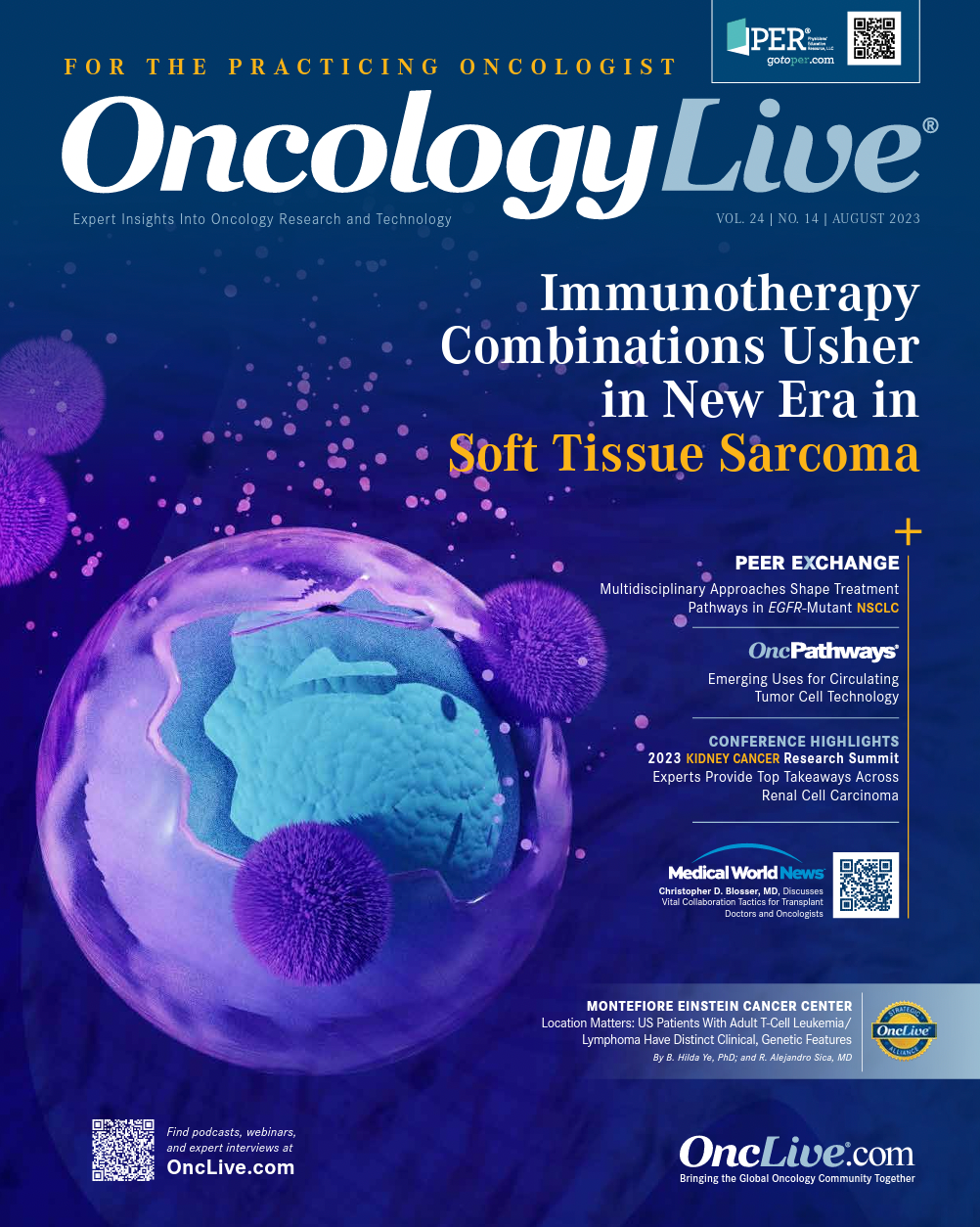Commentary
Article
Oncology Live®
Unresolved Issues in Antineoplastic Drug Therapy: Is It Finally Time to Address?
Author(s):
Several articles featured in a recent issue of the highly respected publication the Medical Letter on Drugs and Therapeutics highlight themes across drug development that are relevant within the broad antineoplastic arena. The topics range from appropriate control arms in randomized clinical trials to sponsorship of trials to the rationale for developing novel agents when suitable, cost-effective biosimilar and generic products are available.
Maurie Markman, MD

Several articles featured in a recent issue of the highly respected publication the Medical Letter on Drugs and Therapeutics highlight themes across drug development that are relevant within the broad antineoplastic arena. The topics range from appropriate control arms in randomized clinical trials to sponsorship of trials to the rationale for developing novel agents when suitable, cost-effective biosimilar and generic products are available.
It is important to acknowledge that statements regarding efficacy, comparisons between agents, and stated drug costs within the journal’s content have been accepted as being scientifically and factually accurate and unbiased regarding individual pharmaceutical manufacturers. Further, there is no intent by this commentator to suggest inappropriate regulatory or financial actions by any company.
Identifying the Control
It is not difficult to find multiple settings within the cancer domain where several possible antineoplastic options are available but no direct comparative data exist to assist oncologists in the selection of optimal therapy for their patients. Why not insist as a cancer community that mechanisms be established to systematically address these questions?
As a backdrop for this topic, consider the first class of drugs discussed in this issue of the Medical Letter: the agents recently approved by the FDA to prevent the recurrence of Clostridioides difficile infection,1 a clinically relevant and potentially serious condition for many, including patients with cancer. The article’s focus is on the recent approval of fecal microbiota spores, live-brpk (Vowst), an orally administered capsule. In line with the journal’s highly respected format, the discussion includes several other agents approved by the FDA for this specific clinical indication. Further, a well-described therapeutic process not approved by the FDA—whereby donor fecal material is mechanically delivered to the affected patient’s gastrointestinal tract—is noted as an alternative strategy.1
The approval of fecal microbiota spores, live-brpk and the other now commercially available agents was based on randomized trial data comparing the active investigational drug with a placebo control. The article notes that no direct comparative trials have been done between the 2 other approved agents or with direct donor fecal transfer. Finally, although the methods of administration for the agents (oral capsule, intravenous infusion, and rectal delivery) differ, which may be a clinically relevant consideration, there is also a substantial difference in the financial impact of therapy, with the cost of one treatment course for the newly approved oral agent being 4.6 times greater than the intravenous strategy.1
The question to be asked is: Why were these agents approved based on superiority to a placebo control rather than fecal donor transplant? And, even if the first approval of an agent to prevent C difficile recurrence mandated a placebo control, should all future regulatory approvals be required to demonstrate superiority to a strategy already shown to be superior to placebo, even recognizing the differences in the methods of administration? What happens now that there are several drugs on the commercial market with rather impressive cost differences and no studies that have directly compared their respective efficacy or toxicities?
Recognizing the void in what this commentator would label critical data on which to make optimal clinical decisions, should it be the role of the FDA or perhaps a consortium of third-party payers (eg, Centers for Medicare & Medicaid Services, large health insurance companies) and/or health systems to work together to organize and fund a pragmatic clinical trial that directly compares these approaches?
Expanding on that topic, a second article in the Medical Letter discussed a highly provocative, prespecified secondary analysis of a randomized trial, findings from which suggest that the administration of metformin (compared with placebo) for 14 days to individuals who tested positive for SARS-CoV-2 infection significantly reduced the risk of developing long COVID.2,3 The article notes that a 14-day supply of metformin, long a generic medication, costs $1.50 and concludes with the following: “Off-label use of metformin to prevent long COVID in high-risk patients with normal renal function is reasonable, but confirmatory data from a trial more specifically focused on long COVID would be welcome.”2
A question that arises is: Who is the appropriate sponsor of such a confirmatory trial for a drug costing $1.50 for a 14-day supply? Should the conduct of a study that has the potential to be critically important and clinically relevant become a component of and be funded by the National Institutes of Health? Or would it be reasonable to again propose that a consortium of third-party payers and large health care organizations be asked/mandated to undertake this novel effort?
Cost vs Innovation
The final 2 articles highlighted in this issue of the Medical Letter address the question of cost. The first notes the recent approval of the new bone marrow stimulatory agent eflapegrastim-xnst (Rolvedon) for the prevention of chemotherapy-induced febrile neutropenia.4 The agent was FDA approved based on the results of 2 randomized trials in which it demonstrated noninferiority in one trial and possible superiority in the other trial vs pegfilgrastim (Neulasta).
Although there should always be interest in discovering novel, increasingly effective, less toxic approaches to supportive care measures in cancer management, the question here is the value of such agents vs less expensive biosimilar agents employed for this purpose. One dose of eflapegrastim is said to cost $4500 compared with pegfilgrastim biosimilar costing approximately $2500. This sum is not insignificant considering the common use of bone marrow stimulatory agents by oncology practices and health care systems, as well as the financial impact on third-party payers or as increasingly mandated insurance co-pay for individual patients.
The second article on cost discusses a newly approved agent for use in individuals with major depression who have failed standard monotherapy with an antidepressant.5 The focus is on cariprazine (Vraylar), a second-generation antipsychotic drug, but again the discussion notes multiple agents that might be appropriately considered in this difficult clinical setting.
For example, one generically available drug, aripiprazole (Abilify), which the article states “has the most data supporting its efficacy and safety for adjunctive treatment of major depressive disorder,” costs approximately $29.00 for a 30-day supply, whereas cariprazine has a cost of $1377.70 for 30 days of treatment, an almost 50-fold greater cost. The article concludes that “in patients who require augmentation therapy, generic aripiprazole, which has a long record of efficacy and safety and costs most less, should be tried first.”5
This appears to be a perfectly rational conclusion, except when one considers the potentially modest financial rewards for a pharmaceutical manufacturer that follows the business decision to produce inexpensive generics, such as metformin or many well-established and highly effective antineoplastic agents such as cisplatin or carboplatin.
What can be done to enhance the market for such essential generic drugs?
References
- Live fecal microbiota oral capsules (Vowst) for the prevention of CDI recurrence. Med Lett Drugs Ther. 2023;65(1677):81-82. doi:10.58347/tml.2023.1677a
- COVID-19 update: metformin to prevent long COVID? Med Lett Drugs Ther. 2023;65(1677):87-88. doi:10.58347/tml.2023.1677e
- Bramante CT, Huling JD, Tignanelli CJ, et al; COVID-OUT Trial Team. Randomized trial of metformin, ivermectin, and fluvoxamine for COVID-19. N Engl J Med. 2022;387(7):599-610. doi:10.1056/NEJMoa2201662
- Eflapegrastim (Rolvedon) for prevention of chemotherapy-induced febrile neutropenia. Med Lett Drugs Ther. 2023;65(1677):83-84. doi:10.58347/tml.2023.1677b
- Cariprazine (Vraylar) for adjunctive treatment of depression. Med Lett Drugs Ther. 2023;65(1677):84-86. doi:10.58347/tml.2023.1677c







%20(2)%201-Recovered-Recovered-Recovered-Recovered-Recovered.jpg?fit=crop&auto=format)

%20(2)%201-Recovered-Recovered-Recovered-Recovered-Recovered.jpg?fit=crop&auto=format)
%20(2)%201-Recovered-Recovered-Recovered-Recovered-Recovered.jpg?fit=crop&auto=format)